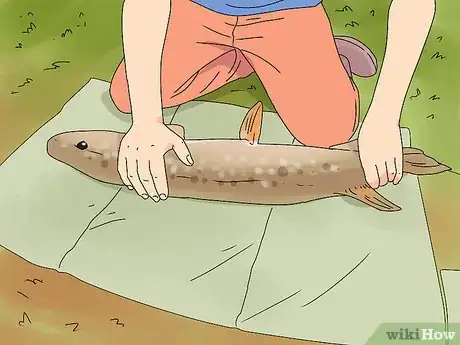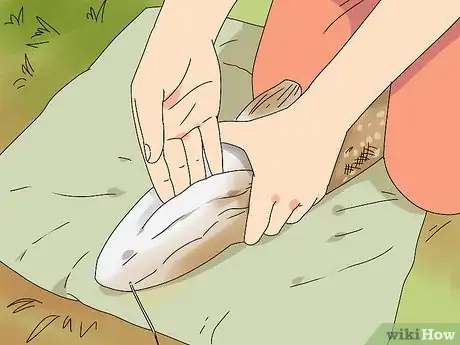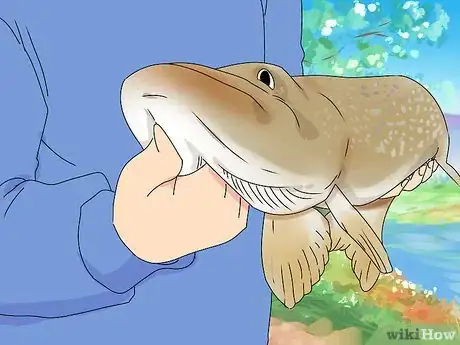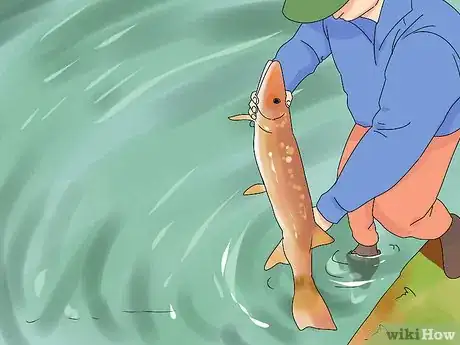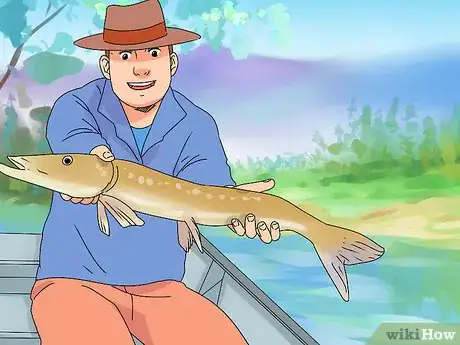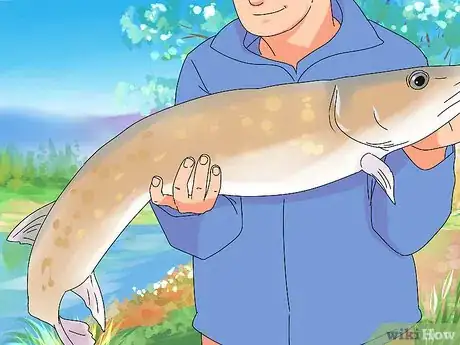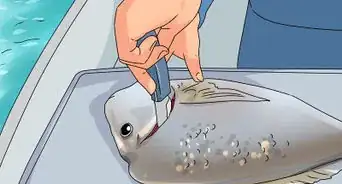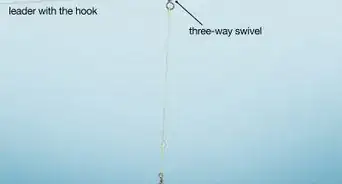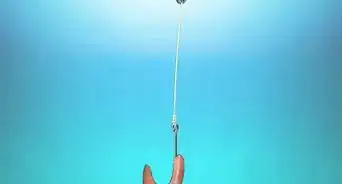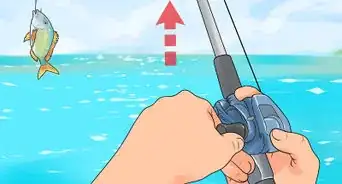This article was co-authored by wikiHow Staff. Our trained team of editors and researchers validate articles for accuracy and comprehensiveness. wikiHow's Content Management Team carefully monitors the work from our editorial staff to ensure that each article is backed by trusted research and meets our high quality standards.
This article has been viewed 28,837 times.
Learn more...
Pike are an impressive breed of fish to look at due to their large size. In order to take a photo or record the measurements of a pike, you will need to hold it securely. If your pike is larger than about 2 kilograms (4.4 lb), use the gill cavity grip to hold it. If your pike is smaller than about 2 kilograms (4.4 lb), grip it around the neck. Regardless of the size of the pike, always put a hand under its belly to support its organs. Enjoy being up close to this majestic fish!
Steps
Holding Large Pike
-
1Place the pike on a landing mat. This gives you a flat surface to lay the pike on. This is particularly useful if you are on a rocky or muddy surface. For large pike, use a landing mat that is at least 1 metre (3.3 ft) wide and long, as this gives room for the pike to lie flat.[1]
- If you don’t have a landing mat, place the pike on the flattest nearby surface.
-
2Slip your fingertips between the gills and the plates. When catching many fish, it is common practice to hold them by the gills. However, it is as important not to use this grip on pike fish, as they have teeth in their gills. Instead, pull the gill flap back and place 3 or 4 fingertips into the cavity between the gills and the gill plate. You will be able to see clearly see the space that is free of teeth! Use your free hand to hold down the fish.[2] |
- If the pike’s head is pointing toward the left, place your left fingertips between the gills and the plates. Alternatively, if the head pointing toward the right, place your right fingertips between the gills and the plates.
- The gill flap is located underneath the mouth of the fish.
- The gill plate is the roof of the gill cavity.
Advertisement -
3Clench your fingertips toward yourself to control the jaw of the pike. Bend the fingertips on your hand that is in the gill flap as close to the palm of your hand as you can. This gives you a firm grip on the jaw of the pike and allows you to carry the bulk of its weight. Use your free hand to stop the fish from moving around too much.[3]
- Avoid putting your whole fingers into the gill plates, as this can cause them to sit near the teeth. Instead, simply put your fingertips up to your second knuckle into the fish.[4]
-
4Support its belly when taking photos or putting it back in the water. When picking up a pike that is more than about 2.5 kilograms (5.5 lb), it is especially important to place 1 hand underneath its belly. This helps to support its organs and also gives you a more secure grip on the fish.[5]
- Avoid holding the fish vertically, as this can put unnecessary pressure on its organs.[6]
- Use your spare hand to support the belly.
Holding Small Pike
-
1Lay the pike on a landing mat. This provides a flat and grippy surface to lay the pike. Place the pike on the middle of the mat to keep it from wriggling back into the water. Purchase a landing mat online or from a fishing store.[7]
- Small pike are less than 2 kilograms (4.4 lb). As a result, any regular sized landing mat is appropriate for this sized fish.
-
2Grip the neck with a firm hold. Wrap your dominant hand right around the neck of the pike, just below the mouth. This grip is the best option for small pike, as the traditional gill hold that is used on larger pike shouldn’t be used on these fish due to their small gill cavities.[8]
- If the fish is particularly wriggly, put on a pair of gloves to give yourself a better grip.
-
3Hold the pike in the middle of the belly to support its organs. Avoid holding the pike vertically, as this puts a lot of pressure on its organs. Instead, lift up the belly of the fish with your free hand to bring it to a horizontal position. This also helps to stop the pike from moving.[9]
- This grip is particularly useful for taking a photo with the pike.
Warnings
- Avoid holding pike for longer than necessary to avoid distress. Try to take any photographs and measurements of the fish as quickly as possible, as leaving the pike out of the water for long periods can cause it to get stressed. As soon as you have recorded the details of the fish, place it gently back into the water.[10]⧼thumbs_response⧽
- Whilst pike can look a little scary, it is important to treat them with respect. In many countries, cruelty to animals is a criminal offence, so be careful to treat the pike kindly.⧼thumbs_response⧽
References
- ↑ https://youtu.be/Fyxj8hpcy9k?t=78
- ↑ https://www.anglersmail.co.uk/blogs/big-fish-thursdays/unhooking-pike-45013
- ↑ https://globalflyfisher.com/fish-better/pike-landing
- ↑ https://youtu.be/Fyxj8hpcy9k?t=39
- ↑ https://www.northernontario.travel/northeastern-ontario/how-to-properly-hold-a-fish
- ↑ https://www.northernontario.travel/northeastern-ontario/how-to-properly-hold-a-fish
- ↑ https://youtu.be/Fyxj8hpcy9k?t=78
- ↑ https://globalflyfisher.com/fish-better/pike-landing
- ↑ https://globalflyfisher.com/fish-better/pike-landing
